Bulletin – June 2014 Payments Cash Use in Australia
- Download the article 1.05MB
Abstract
This article uses results from the 2013 Survey of Consumers' Use of Payment Methods and regression analysis to examine trends in cash use in Australia. The results show that cash remained the most common form of payment, though its use relative to other payment methods has declined over recent years. Older participants were more likely to use cash than younger participants and all participants were more likely to use cash for low-value transactions relative to other payment methods. In addition, participants were asked about their holdings of banknotes in their ‘wallet’ (i.e. on their person) and elsewhere, with the results suggesting that cash – particularly high-value denominations – was being used as a store of value and not just for transactional purposes.
Introduction
The Reserve Bank of Australia is responsible, under the Reserve Bank Act 1959, for the production, issue, reissue and cancellation of Australia's banknotes. Banknotes are used by the public as a payment method and as a store of value. While there is information on the number and value of banknotes in circulation and on withdrawals from automated teller machines (ATMs), data on the use of banknotes by the public are limited. With this partly in mind, the Reserve Bank conducted the third Survey of Consumers' Use of Payment Methods (the survey) in November 2013, following previous surveys in 2007 and 2010.[1]
The survey primarily comprised two components: a diary that participants filled in over seven days; and an end-of-survey questionnaire. In the diary, participants reported details of all transactions made, including the transaction value, the payment method, the payment channel (e.g. point of sale or internet) and the merchant category. Participants were also asked about the cash they obtained (cash ‘top-ups’), including the value, the method of obtaining it, and the value of banknotes held following the top-up. In the 2013 survey, 1,167 participants recorded around 15,500 payments totalling over $1.1 million, and around 1,700 cash top-ups.[2] In the end-of-survey questionnaire, participants answered questions relating to their payment preferences, banknote holdings, substitution with new payment methods and use of direct debits.
Drawing on data from the survey, this article explores cash use from three perspectives. First, it looks at cash as a payment mechanism and evaluates who uses cash to make payments and the type of payments they make. Second, banknote holdings for transaction purposes (i.e. banknotes in wallets) and the denominations participants held for conducting transactions are examined. Finally, the article presents some information on cash holdings that potentially reflect the use of cash as a store of value.
Background
The main source of contemporaneous data on cash is the stock of banknotes in circulation. These data show that the number of banknotes in circulation has been rising, on average, by around 5 per cent per annum over the past decade. This has occurred despite the significant increase in the use of electronic payments. However, not all banknotes on issue have increased at the same rate (Graph 1). The number of high-value denominations in circulation – $50 and $100 banknotes – has increased much faster than the number of low-value denominations – $5, $10 and $20 banknotes. Indeed, between them, the $50 and $100 banknotes now account for around two-thirds of the number of banknotes in circulation.
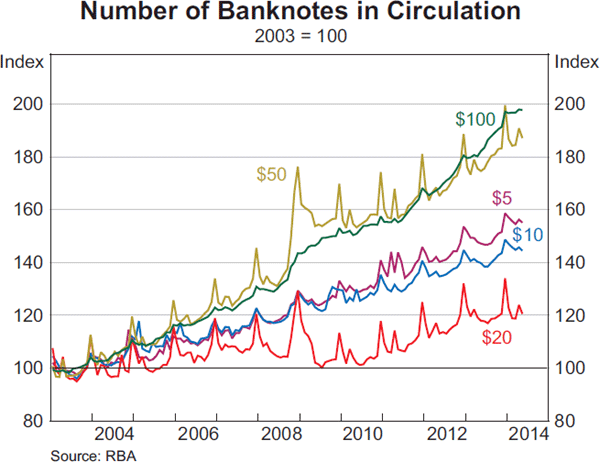
Notwithstanding the continued rise in the number of banknotes in circulation, there is some evidence that the use of cash in transactions has declined relative to other payment methods. The main indicator of this is the growth in the value of cash withdrawals relative to the growth in nominal household consumption. While nominal household consumption has grown at an average annual rate of 6 per cent over the past decade, cash withdrawals (including ATM withdrawals, eftpos cash out and over-the-counter cash withdrawals at bank branches) have grown at an average annual rate of just 2 per cent.[3]
While these data suggest that the importance of cash as a payment method is declining, they do not provide any insights into the use of cash by consumers and the factors that might affect it. The surveys conducted by the Reserve Bank in 2007, 2010 and 2013 provide some insights. The following sections set out the key findings from these survey data.
Cash Payments
As in the 2007 and 2010 surveys, cash was the most frequently used payment instrument in the 2013 survey but its use declined compared with earlier surveys. Cash accounted for 47 per cent of the number of transactions in the 2013 survey, compared with 69 per cent of transactions in the 2007 survey (Graph 2). While cash was the most frequently used method of payment in the 2013 survey, cards (including all debit and credit cards) were used nearly as often.
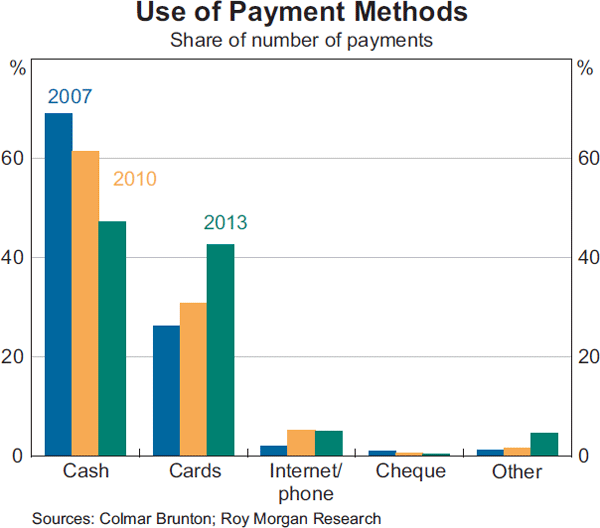
Consistent with the previous surveys, cash was the preferred payment method for low-value transactions.[4] Participants used cash to make 69 per cent of payments worth $20 or less, but only 13 per cent of payments exceeding $100 (Graph 3). The median value of a cash transaction in the 2013 survey was around $12, which was little changed from 2007. Although participants indicated in the end-of-survey questionnaire that they were generally comfortable making a cash payment worth up to $200, they clearly preferred other methods for payments of this size. The share of payments undertaken using cash declined across all payment values since 2007, suggesting a broad-based shift in payment preferences away from cash to alternative payment methods.
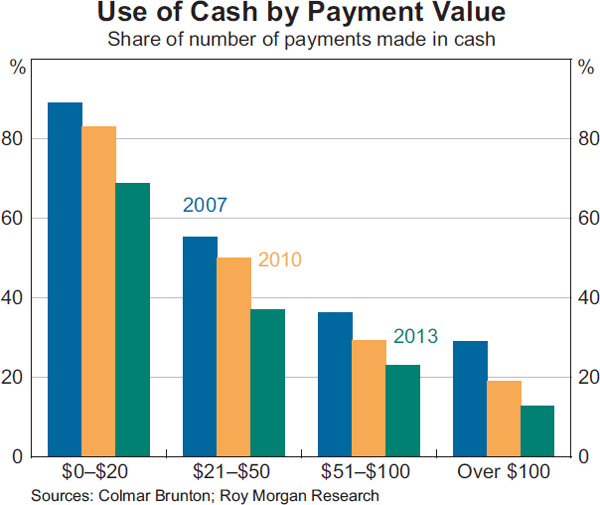
As cash was used more frequently for lower-value than for higher-value transactions, it accounted for a smaller share of the value of payments compared with the number of payments. Cash accounted for 18 per cent of the value of the surveyed transactions in 2013, while cards accounted for 53 per cent of the value of transactions (Graph 4).
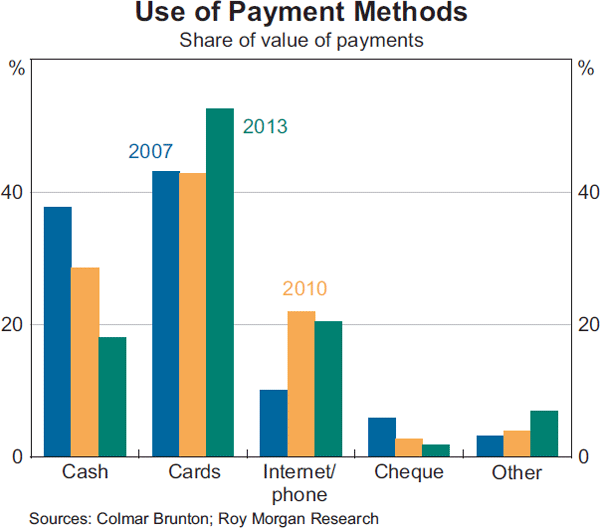
In order to understand why some consumers continue to use cash despite the prevalence of alternative payment mechanisms, survey participants were asked why they used cash at the point of sale. Around one-quarter of participants identified avoiding credit card surcharges as the most important factor, around one-fifth of participants stated speed or ease of transaction, and a similar proportion indicated a preference for using their own funds (Graph 5). Only 3 per cent of participants indicated privacy as the most important reason for using cash.
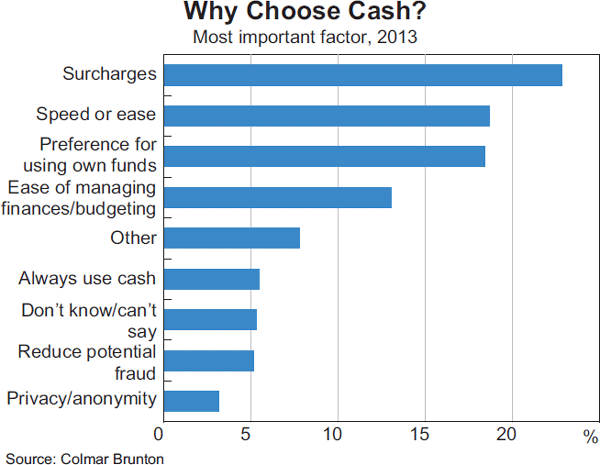
Factors Affecting Cash Use
Previous studies, both international and domestic, have found that cash use varies with demographic factors, such as age and income.[5] These studies have generally found that other factors, such as the size of the payment and merchant type are also important in determining whether cash is used in transactions. The 2013 survey provides very similar results to these previous studies.
A result consistent across each of the Australian surveys was that those who are older had a stronger preference for cash than younger age groups. Cash payments accounted for around 60 per cent of all payments made by participants aged 65 years and over in the 2013 survey, much higher than the share of payments made using cash by participants in all other age groups (Graph 6). This difference did not occur because participants aged 65 years and over conducted a higher proportion of low-value transactions (for which cash was typically preferred) compared with participants aged between 25 and 64 years (Table 1). This suggests that those aged 65 years and over preferred to use cash over other payment methods. In contrast, 18–24 year olds' cash use as a share of the number of transactions was higher than the next age cohort (25–34 years), which was consistent with the tendency for 18–24 year olds to have a higher share of low-value payments.
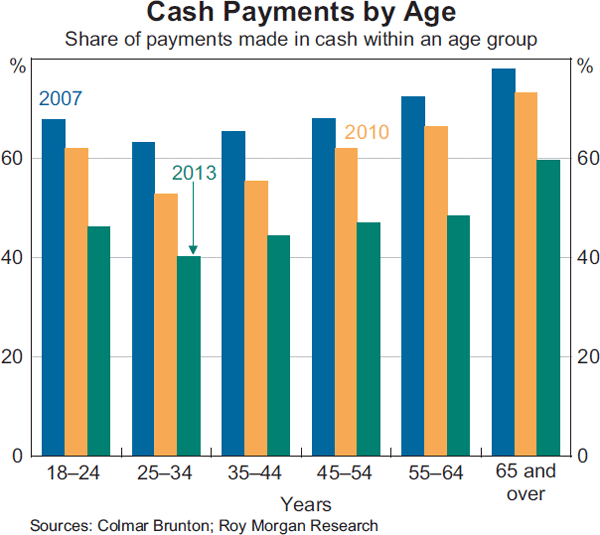
| 2007 | 2010 | 2013 | |
|---|---|---|---|
| 18–24 | 56 | 60 | 62 |
| 25–34 | 51 | 51 | 46 |
| 35–44 | 53 | 49 | 47 |
| 45–54 | 54 | 50 | 47 |
| 55–64 | 58 | 54 | 44 |
| 65 and over | 58 | 53 | 47 |
| Overall | 55 | 52 | 48 |
|
Sources: Colmar Brunton; Roy Morgan Research |
|||
While the relative use of cash between age groups was little changed across all three surveys, the decline in cash use as a share of transactions over time was evident across all age groups. Specifically, cash use as a share of total transactions has declined for all age groups by around 20–25 percentage points since the 2007 survey.
The survey results also showed that the share of the value of cash payments was lower for participants in households with higher incomes than it was in households with lower incomes (Graph 7). While individuals in households with incomes greater than $110,000 used cash for about 10 per cent of the value of their purchases, cash accounted for around 30 per cent of the value of transactions for individuals in the lowest income bracket (less than $20,000) and around 20 per cent for individuals in households in the next income bracket ($20,000–$49,999). This could reflect limited access of low-income households to credit relative to high-income households (Arango et al 2012). It is also possible, however, that cash was used for similar purchases regardless of income, but these purchases accounted for a larger proportion of low-income earners' overall consumption. The results from the survey showed that the average cash payment at merchant categories where more non-discretionary spending occurs (e.g. supermarkets) was broadly similar across income groups.

Survey participants in some occupations made a relatively large share of their payments using cash, with little variation evident across other groups (Graph 8). These included community or personal services workers (such as hairdressers and cleaners), technicians or trade workers, or who did not have an occupation (including retirees, students, the unemployed and others not looking for work). The results reflect the possibility that employees in some occupations may tend to receive more payments in cash, be on lower incomes, work part time or be older.
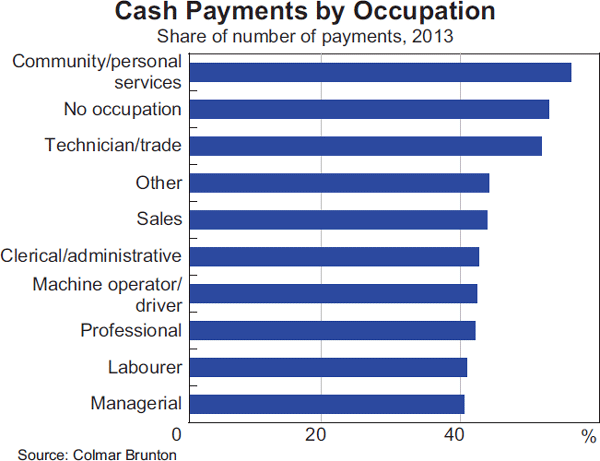
While the results presented above provide some insight into the impact of demographic characteristics on the use of cash and potential reasons for the changes observed in cash use, the correlation between demographic factors makes it difficult to disentangle their relative importance. A regression model was therefore estimated, using data from all three surveys to estimate how the probability of using cash at the point of sale varied by factors such as age, household income, transaction size and merchant type.[6] Importantly, a regression makes it possible to isolate the effect of each factor by controlling for all other variables in the regression (see Appendix A for the full regression results).
The results confirmed that, with other demographic and transaction-based variables held constant, the probability of using cash at the point of sale increased with age. For example, over the three surveys, participants aged 65 years and over were between 13 and 17 percentage points more likely to use cash at the point of sale relative to individuals aged between 18 and 24 years.
Interestingly, household income was generally not a significant factor in predicting the likelihood of paying with cash. The likelihood of using cash was not statistically different for different levels of household income, with the exception of the highest household income bracket ($110,000 and over), which was statistically less likely to use cash. Similarly, owning a credit card exhibited no explanatory power in the regression, which by itself suggests that a lack of access to credit does not explain why the share of payments made with cash was higher for low-income groups. The results suggest, however, that people who paid the full balance of their credit card account before the due date were less likely to use cash to make purchases than individuals who did not.
The regression results also indicated that occupation was not a statistically significant predictor of cash use, with only trade workers and technicians significantly more likely to use cash. It may be that other factors were generating the survey result that participants in some industries seemed more likely to use cash. For example, the initial effect observed for people without an occupation and for community or personal services workers could be largely driven by age.
Many transaction-based factors were significant in predicting whether cash was used at the point of sale. Other things equal, individuals were 49 percentage points more likely to make a payment in cash for values of $20 or less relative to values exceeding $100. In addition, the merchant type was highly significant in predicting whether cash was used, with cash most likely to be used at a pub or bar and for household bills, and least likely to be used for medical costs and holiday spending.
The regression results can also be used to estimate whether, after controlling for all other demographic and transaction-based factors, there was a difference in the likelihood that a payment was made in cash across the three surveys. The results were significant with a payment 15 percentage points less likely to be made in cash in 2013 than in 2007. One factor behind this result could be the adoption of new payment technologies, such as contactless card payments, which could not be controlled for specifically in the regression. New payment technologies are faster at the point of sale than traditional credit and debit card payments, potentially counteracting the relative speed of making cash transactions. However, this may not explain the shift away from cash use entirely, since the end-of-survey questionnaire showed that younger participants were more willing to use newer payment technologies relative to older participants, and the decline in cash use was broad based across all age groups.
Other factors (that were not controlled for in the regression) could also explain the result that a payment made in 2013 was less likely to be made in cash. These include an increase in remote payments (such as over the internet) for which cash would not be an option, the increased availability of card acceptance terminals at the point of sale and the removal of limits on the number of fee-free debit card transactions over recent years.[7]
Banknotes in Wallets
In addition to recording transactions, participants in the survey were asked to record the number and value of banknotes held in their wallet. Participants held a median of three banknotes in their wallet with a value of $55 in 2013, up slightly from around $50 in 2010 (Table 2). The value of banknotes held in wallets increased with age. Participants aged 65 years and over typically held $80 more than individuals aged between 18 and 24 years and $60 more than individuals aged between 35 and 44 years. The mean value of banknotes held in wallets was close to double the median value, as there was a small number of participants holding a large value of banknotes.
| Value ($) | Number | ||||
|---|---|---|---|---|---|
| Median | Mean | Median | Mean | ||
| 18–24 | 30 | 60 | 2 | 3 | |
| 25–34 | 40 | 73 | 3 | 3 | |
| 35–44 | 50 | 92 | 3 | 4 | |
| 45–54 | 65 | 125 | 3 | 5 | |
| 55–64 | 70 | 118 | 4 | 5 | |
| 65 and over | 110 | 191 | 5 | 7 | |
| Overall | 55 | 112 | 3 | 5 | |
|
Source: Colmar Brunton |
|||||
In order to disentangle the importance of potentially correlated determinants of the value of banknotes held in wallets, an additional regression was estimated using similar variables as the regression above (see Appendix B for the full regression results).[8] The results showed that age was significant in determining the value of banknotes held in a participant's wallet, with each additional year in age associated with an increase of $2.18 in the expected value of cash held, holding all else constant. Another notable result was that labourers were estimated to have held an extra $96 in banknotes in their wallets.
Unlike cash transactions, the results suggested that banknote wallet holdings were significantly influenced by income. Participants earning under $20,000 and between $20,000 and $49,999 were estimated to carry $49 and $41 less, respectively, than individuals earning between $50,000 and $79,999 per year. Those on incomes between $50,000 and $79,999 did not carry statistically different values of cash in their wallet compared with individuals who earned $80,000 and above, suggesting that preferences for holding cash did not change once a middle-income threshold was met. Further, wallet holdings were estimated to be $37 higher for individuals who paid their credit card balance in full compared with individuals who did not.
Participants were also asked to record the composition of banknote denominations held in their wallet, with $50 banknotes being the most commonly held denomination. The proportion of different denominations held varied by age with older participants holding more $50 banknotes in their wallet (Graph 9).
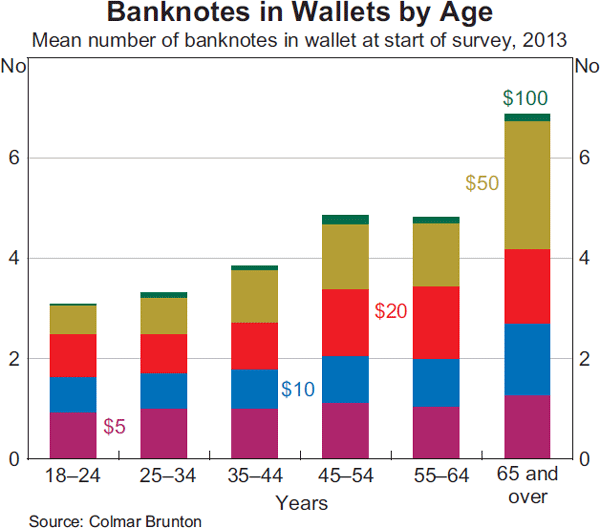
Comparing the number of banknotes of each denomination held in participants' wallets with the proportions implied by the number of banknotes in circulation provides an indication of whether some denominations are being used as a store of value. Of the banknotes in participants' wallets, the share of the number of low-value banknotes was considerably higher than the proportion implied by the share of these banknotes in circulation (Graph 10). In contrast, the share of high-denomination banknotes in wallets was considerably lower than the share in circulation. This is consistent with the premise that high-denomination banknotes are being used as a store of value rather than as a medium of exchange, and may explain why the number and value of banknotes in circulation have continued to grow at around 5 and 6 per cent per annum, respectively, despite an apparent decline in the importance of cash for transactions.
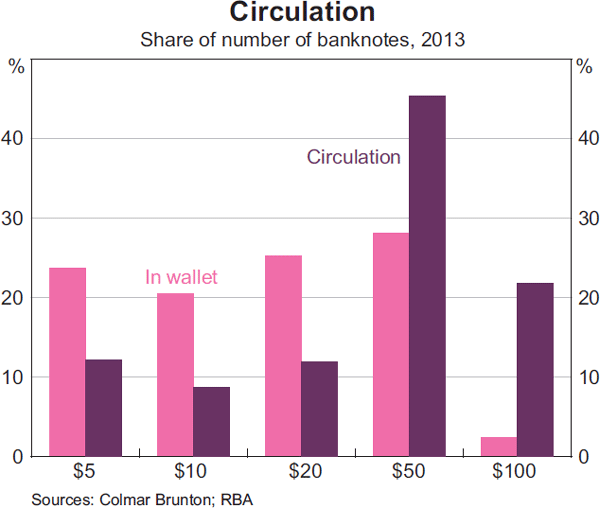
Cash Holdings
To explore how people may be using cash as a store of value, survey participants were asked to state the value of cash that they held in places other than their wallet. Around three-quarters of participants indicated that they held cash in other places, with 12 per cent of people stating that they held over $500 (Graph 11). In addition to making a higher share of cash payments and holding more banknotes in their wallet, older participants also tended to store cash in places other than their wallet. In particular, around 16 per cent of participants aged 65 years and over held more than $500 in places other than their wallet, while only 9 per cent of 18–24 year olds and 5 per cent of 25–29 years olds stored the same amount.
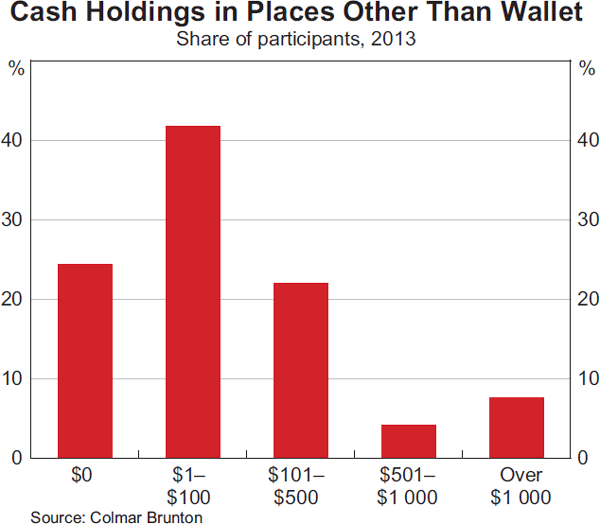
As expected, the main reason that participants gave for holding banknotes in their wallet or elsewhere was to fund day-to-day transactions. Looking at options other than day-to-day transactions, participants indicated that the most important reason for holding cash was for emergency transaction needs (36 per cent; Graph 12). Considerations relating to obtaining cash were also an important reason for people storing cash. In particular, minimising time spent withdrawing cash, reducing ATM fees and limited access to ATMs accounted for a further 41 per cent of responses.
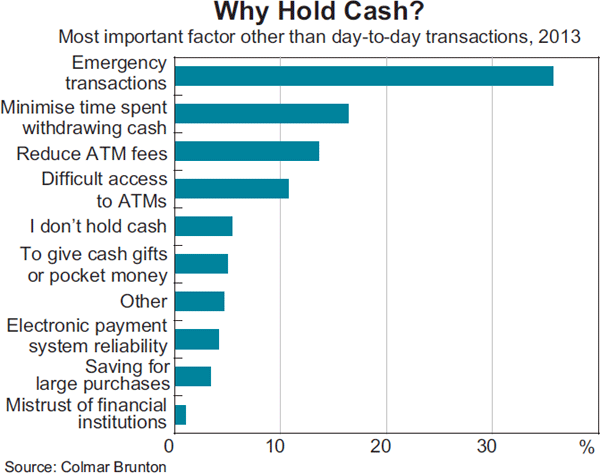
Conclusion
Results from the 2013 Survey of Consumers' Use of Payment Methods indicated that cash remained the most frequently used payment method for day-to-day transactions, though its use relative to other payment methods has declined over recent years. Age was an important factor in determining preferences for the use of cash, with older participants more likely to use cash than younger participants. Consistent with previous surveys, participants were more likely to use cash for low-value transactions relative to other payment methods. Given the continued preference for cash of older participants in the survey, and the dominance of cash for low-value transactions, these results suggest that cash is likely to remain an important part of the payments system for the foreseeable future.
The survey responses and regression results also indicated that older participants and those on higher incomes held more banknotes in their wallets than younger participants and lower-income earners. More broadly, the results suggested that high-denomination banknotes were used as a store of value, with around three-quarters of participants indicating that they held banknotes in places other than their wallet. This is likely to continue to underpin the demand for higher-denomination banknotes.
Appendix A: Probit Regression Results
| Independent variables | Coefficient(d) | Change in probability | |
|---|---|---|---|
| Year of survey | 2010 | −0.24* | −0.08 |
| 2013 | −0.47*** | −0.15 | |
| Age (years) | 18–24 | −0.12 | −0.04 |
| 25–29 | −0.11 | −0.04 | |
| 30–34 | −0.10 | −0.04 | |
| 40–44 | 0.05 | 0.02 | |
| 45–49 | 0.10 | 0.04 | |
| 50–54 | 0.04 | 0.02 | |
| 55–59 | 0.23** | 0.09 | |
| 60–64 | 0.16 | 0.06 | |
| 65 and over | 0.33** | 0.13 | |
| Household income | Less than $20,000 | −0.09 | −0.03 |
| $20,000–$49,999 | −0.11 | −0.04 | |
| $80,000–$109,999 | −0.04 | −0.01 | |
| $110,000 and over | −0.21*** | −0.07 | |
| Gender | Male | −0.04 | −0.01 |
| Location | Non-capital city | 0.04 | 0.01 |
| Employment status | Part time | −0.04 | −0.01 |
| Self employed | −0.15 | −0.05 | |
| Not employed/unemployed | 0.41 | 0.16 | |
| Student | −0.03 | −0.01 | |
| Retired | 0.26 | 0.10 | |
| Look after house | 0.17 | 0.06 | |
| Occupation | No occupation | −0.03 | −0.01 |
| Managerial | −0.02 | −0.01 | |
| Technician/trade/machine operator or driver | 0.22* | 0.08 | |
| Community/personal services | 0.27 | 0.10 | |
| Clerical/administrative | 0.01 | 0.00 | |
| Sales | 0.01 | 0.00 | |
| Labourer | 0.02 | 0.01 | |
| Other occupation | −0.10 | −0.04 | |
| Maximum education | Year 10 or below | 0.01 | 0.00 |
| Years 11 or 12 | −0.09 | −0.03 | |
| Trade certificate | −0.01 | −0.00 | |
| Diploma | −0.03 | −0.01 | |
| Other education | −0.33 | −0.11 | |
| Card ownership | Does not own a credit card | 0.12 | 0.04 |
| Card behaviour | Transactor(e) | −0.14** | −0.05 |
| Merchant category | Food store | 0.75*** | 0.29 |
| Electrical store | 0.02 | 0.01 | |
| Other retailer | 0.21*** | 0.08 | |
| Takeaway store | 0.70*** | 0.27 | |
| Café | 0.77*** | 0.30 | |
| Pub | 1.15*** | 0.43 | |
| Petrol store | −0.03 | −0.01 | |
| Transport | 0.46*** | 0.18 | |
| Leisure | 0.84*** | 0.33 | |
| Holiday | −0.05 | −0.02 | |
| Household bills | 0.92*** | 0.36 | |
| Medical | −0.11 | −0.04 | |
| Services | 0.89*** | 0.34 | |
| Other merchants | 0.90*** | 0.35 | |
| Payment amount | $0–$20 | 1.09*** | 0.41 |
| $21–$50 | 0.34*** | 0.13 | |
| Over $100 | −0.21*** | −0.07 | |
| Constant | −0.42*** | na | |
| Observations | 37,820(f) | na | |
|
***, ** and * represent statistical significance at the 1, 5 and 10 per cent level,
respectively Sources: Colmar Brunton; RBA; Roy Morgan Research |
|||
Appendix B: Tobit Regression Results
| Independent variables | Coefficient | |
|---|---|---|
| Age | 2.18*** | |
| Household income | Less than $20,000 | −49.39** |
| $20,000–$49,999 | −40.93*** | |
| $80,000–$109,999 | −16.81 | |
| $110,000 and over | −8.96 | |
| Gender | Male | 15.51 |
| Location | Non-capital city | −3.97 |
| Employment status | Part time | −30.52** |
| Self employed | −0.80 | |
| Not employed/unemployed | 58.03 | |
| Student | 42.76 | |
| Retired | 82.04* | |
| Welfare | 74.03 | |
| Look after house | 57.45 | |
| Occupation | No occupation | −56.45 |
| Managerial | 51.29 | |
| Technician/trade/machine operator or driver | 10.46 | |
| Community/personal services | 22.94 | |
| Clerical/administrative | −0.76 | |
| Sales | −15.83 | |
| Labourer | 96.49** | |
| Other occupation | −8.32 | |
| Maximum education | Year 10 or below | −18.63 |
| Years 11 or 12 | 7.21 | |
| Trade certificate | 26.84 | |
| Diploma | −9.19 | |
| Other education | 123.48 | |
| Household size | 3.71 | |
| Household structure | Couple with no children | −6.47 |
| Single with no children | 22.88 | |
| Single with children | 30.30 | |
| Live with a group | 6.54 | |
| Other household structure | −0.09 | |
| Debit card | Does not own a debit card | 21.67 |
| Credit card | Does not own a credit card | 4.72 |
| Card behaviour | Transactor(c) | 37.41*** |
| Constant | −23.85 | |
| Observations | 1,122(d) | |
|
***, ** and * represent statistical significance at the 1, 5 and 10 per cent levels,
respectively Sources: Colmar Brunton; RBA |
||
Footnotes
The authors are from Note Issue Department. [*]
For more information about these surveys, see Emery, West and Massey (2008), Bagnall, Chong and Smith (2011), Bagnall and Flood (2011) and Ossolinski, Lam and Emery (2014). The fieldwork for the 2013 survey was undertaken by research firm Colmar Brunton (fieldwork for the 2007 and 2010 surveys was undertaken by Roy Morgan Research). [1]
Payments included all transactions between a consumer and a merchant and did not include transfers between a participant's own accounts, such as the repayment of debt, or transfers to friends or family members. [2]
Cash withdrawals do not increase banknotes in circulation, because banknotes are considered to be in circulation when they leave the Reserve Bank. [3]
The finding that cash was preferred for low-value transactions is consistent with international studies, such as Deutsche Bundesbank (2009), ECB (2011) and Wang and Wolman (2014). [4]
See Emery et al (2008), Deutsche Bundesbank (2009), Bagnall and Flood (2011), Arango, Hogg and Lee (2012), Jonker, Kosse and Hernández (2012), Kosse and Jansen (2013) and Bennett et al (2014). [5]
The regression was a probit model. [6]
The 2013 survey included more demographic information than the previous surveys. To take advantage of this, a second regression was estimated using only 2013 data (in which the base person also lived in a house with her partner and children and owned a debit card). Results from this regression suggest that: not owning a debit card increased the probability of making a cash payment by 12 percentage points; and individuals living by themselves were more likely to use cash. [7]
The regression was a tobit model, which used only the 2013 survey and did not include the transaction value or merchant category variables. [8]
References
Arango C, D Hogg and A Lee (2012), ‘Why is Cash (Still) So Entrenched? Insights from the Bank of Canada's 2009 Methods-of-Payment Survey’, Bank of Canada Discussion Paper No 2012–2.
Bagnall J, S Chong and K Smith (2011), ‘Strategic Review of Innovation in the Payments System: Results of the Reserve Bank of Australia's 2010 Consumer Payments Use Study’, June.
Bagnall J and D Flood (2011), ‘Cash Use in Australia: New Survey Evidence’, RBA Bulletin, September, pp 55–62.
Bennett B, D Conover, S O'Brien and R Advincula (2014), ‘Cash Continues to Play a Key Role in Consumer Spending: Evidence from the Diary of Consumer Payment Choice’, Federal Reserve Bank of San Francisco, FedNotes, April. Available at <http://www.frbsf.org/cash/files/FedNotes_Evidence_from_DCPC.pdf>.
Deutsche Bundesbank (2009), ‘Payment Behaviour in Germany: An Empirical Study of the Selection and Utilisation of Payment Instruments in the Federal Republic of Germany’, June. Available at <http://www.bundesbank.de/Redaktion/EN/Downloads/Publications/Bulletins_and_surveys/ cash_management_2009_payment_behaviour_in_germany.pdf?_blob=publicationFile>.
ECB (European Central Bank) (2011), ‘The Use of Euro Banknotes – Results of Two Surveys Among Households and Firms’, Monthly Bulletin, April, pp 79–90.
Emery D, T West and D Massey (2008), ‘Household Payment Patterns in Australia’, in Payments Systems Review Conference, Proceedings of a Conference, Reserve Bank of Australia, Sydney, pp 139–176.
Jonker N, A Kosse and L Hernández (2012), ‘Cash Usage in the Netherlands: How Much, Where, When, Who and Whenever One Wants?’, DNB Occasional Studies, Vol 10, No 2.
Kosse A and D Jansen (2013), ‘Choosing How to Pay: The Influence of Home Country Habits’, Journal of Banking and Finance, 37(3), pp 989–998.
Ossolinski C, T Lam and D Emery (2014), ‘The Changing Way We Pay: Trends in Consumer Payments’, RBA Research Discussion Paper No 2014–05.
Wang Z and A Wolman (2014), ‘Payment Choice and the Future of Currency: Insights from Two Billion Retail Transactions’, Federal Reserve Bank of Richmond Working Paper No 14–09.